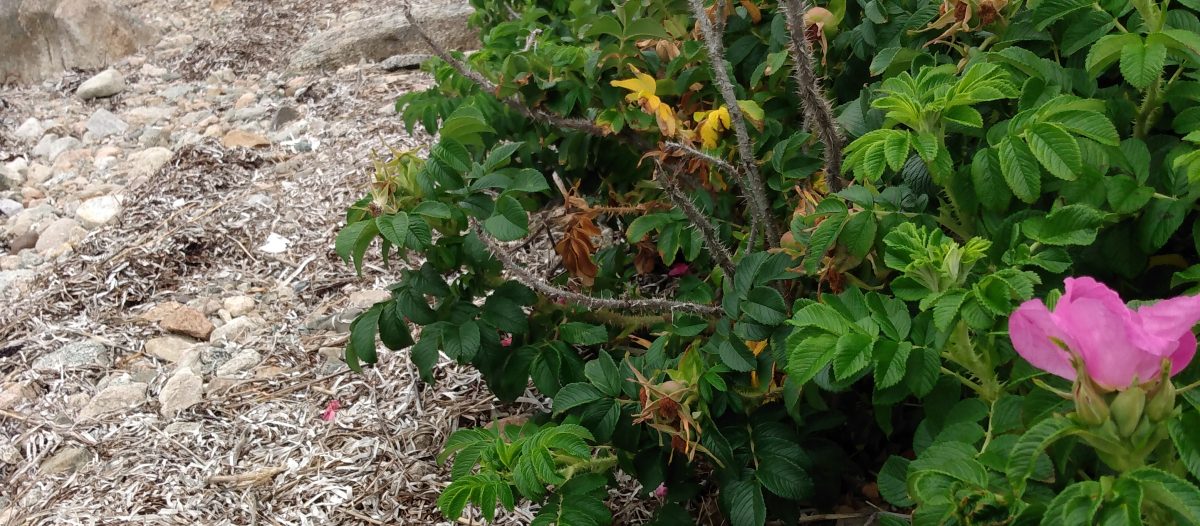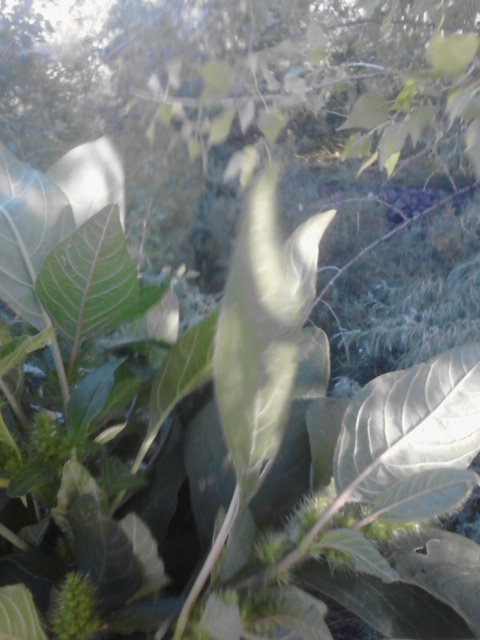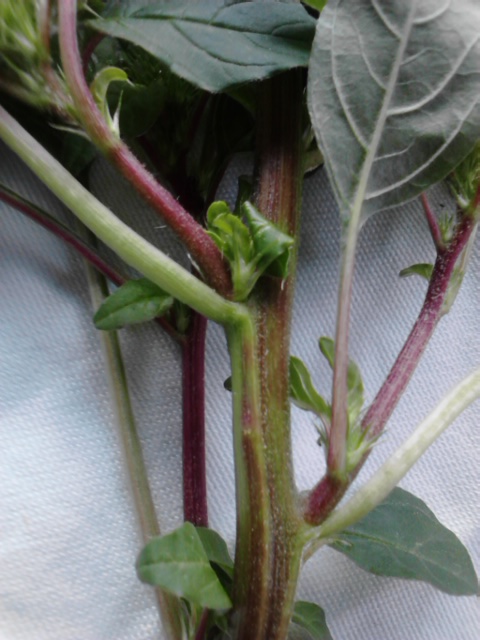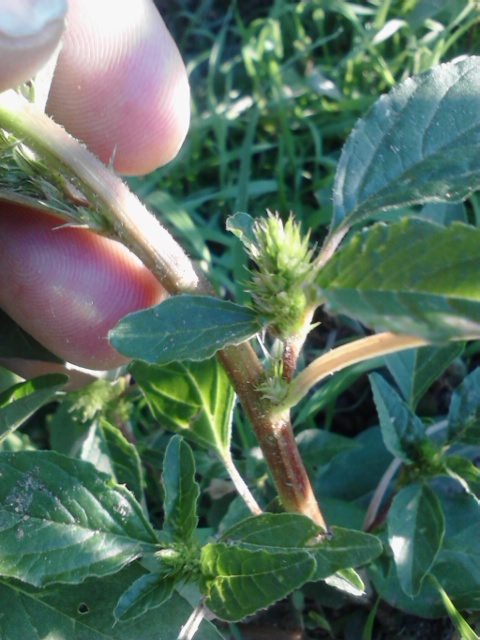Story of a plant and how it helped me find its name.
Amaranth. I found you. You let me find you.
I remember. Looking intently at plants growing near a field of corn in the plains area just west of Denver, Colorado.
You were in the ditches near the field.
Alongside the road that tractors drive on.
Where we walked our dog.
Pigweed is the name that threw me off from you. Hard to latch onto, although pigs have good taste!
I thought the green, spikey cluster of flowers at the top could tip me off that it was, indeed, you.
But the leaves, the stem… the overall characteristics of you, Amaranth.
Wild, green leaved Amaranth.
Was something.
I still was not sure.
Like mistaken identity.
Or a case of amnesia where all I have is a picture to go by
with no name.
It took me over a year of meanderings.
And leavetakings. Learning other plants which made my acquaintance before…
I found you on the upper banks along the foot and bicycle path of the Santa Fe river where I was walking.
A frequent walk which helped me notice you enough to wake up my sleeping vision and actually see you!
(Patch of Amaranth in foreground on bank of river)
(Just a week ago water was rushing through this riverbed. It was bone dry when I took the photo only to rush with water, just a few hours later. Rain from the mountain top making its way down. Perhaps over a course of days…)
The fertile banks of the river.
That is where you greeted me and lead me to understand your introduction. Where I finally learned to meet you. To see you for what you are. Amaranth the immortal green and grain.
(In this location grows near the yellow flowered plant. Looks similar but only one is the edible, healing Amaranth!)
Grateful Harvest
near the riverbed
(Can you see the top Amaranth leaf pointing to a patch of Mullein across the Riverbed?)
………………………………………………………………………………………………………………….
This green, (as it is called in Nigeria. Green!)…
made its patient and hearty introduction to me again.
As silly as this may sound?… plants have a way of helping me find them.
To understand, admire and observe them.
In essence, teaching me by name.
Thankyou Amaranth!
Amaranthus retroflexus
Green Amaranth
Nicknames: Red root pigweed, red-root amaranth, common amaranth, pigweed amaranth, and common tumbleweed.
Amaranth word origins are from the Greek Amarantos which means unfading.
It is believed to have derived from Sanskrit. The Sanskrit word Amar means eternal…unfading.
More word origin here:
“”Amaranth” derives from Greek μάραντος [3] (amarantos), “unfading,” with the Greek word for “flower,” νθος (anthos), factoring into the word’s development as “amaranth.” The more accurate “amarant” is an archaic variant. Also, it has to be mentioned the Greek word amarantos is in fact derived from ancient Indian language Sanskrit and the meaning of the word is immortal immortal.”
Amaranth, given its Sanskrit roots, in India today; Amaranth greens and grain are still a popular food source.
Red root
Stems can be green, tannish green, red, pinkish green
……………………………………………………………………………………………………….
Aztec Use of Amaranth
Aztec art and sculpture
Image source and Aztec Culture
“In ancient Mesoamerica, amaranth seeds were commonly used. The Aztec/Mexica cultivated large quantities of amaranth and it was also used as form of tribute payment.
Amaranth’s name in Nahuatl was huauhtli.
Among the Aztecs, amaranth flour was used to make baked images of their patron deity, Huitzilopochtli, especially during the festival called Panquetzaliztli, which means “raising banners”. During these ceremonies, amaranth dough figurines of Huitzilopochtli were carried around in processions and then divided up among the population…
Cultivation of amaranth decreased and almost disappeared in Colonial times, under the Spanish rule. The Spanish banished the crop because of its religious importance and use in ceremonies.”
Aztec use of Amaranth and quoted source.
But Amaranth survived on the outskirts of Aztec civilization. Thanks to the Aztec people who, perhaps at great risk, saved Amaranth seeds!
Manataka American Indian Council Articles on Amaranth
……..xxxxx…………xxxxxx…………..xxxxx………………..xxxx………………xxx
AMARANTH Some characteristics of identification:
For Amaranthus retroflexus
*Be certain for each type of Amaranth plant as there are 60 – 70 species out there! Although some(not all) characteristics for plant species are consistent.
As always, be certain of what plant you are foraging! Bring an expert. Seek expert advice!
This is a general guide for identifying
Amaranthus retroflexus
* (see above)
.Red root
.Alternating leaves
.Long petiole (leaf stem)
.Leaves can be diamond shaped, lanceolate, oval and often pointed,
.Leaves may be notched when young
.Smaller leaves, higher up on stem
.Leaves can have a slightly wavy edge
.Leaf like growth at stem joints
.Shiny underside of leaf also is white veined.
.These veins are prominent
.Green bristly flower spikes
.Stems can be red, green or pinkish green
.Flower spikes can also form at joints of stems as well
and can surround central, top flower spike.
.Can be branched plant
.Grows in roadsides, disturbed areas, fields, gardens… .Even in arroyos… see end of post 🙂
.Grows to 3 feet on average
illustration credit. Info about plant
Amaranth Traditional Day of the Dead Skulls
Nutrition of Amaranth Leaves per 1 Cup Serving.
Vitamin K 267%, Vitamin C 21%, Manganese 13%, Calcium 7%, Magnesium 5%, Folate 6%… and other nutrients.
wow that’s a lot of Vitamin K!
Medicinal Uses:
“Astringent.
A tea made from the leaves is astringent[222]. It is used in the treatment of profuse menstruation, intestinal bleeding, diarrhoea etc[222, 238, 257]. An infusion has been used to treat hoarseness[257].”
Prominent veins on underside of leaf appear white.
http://extension.psu.edu/pests/weeds/weed-id/redroot-pigweed
…………………………………………………………………………………………………………………….
I foraged a nice bunch of Amaranth leaves and made a simple dish of greens with them along with some community garden greens. (Amaranth was also growing in the garden!)
I was inspired by the cheera Thoran recipes but the process was more of a whimsical concoction.
The recipes I saw said to use oil and heat up mustard seeds until they pop.
I used 3 tbsp sunflower oil
3 tbsp black mustard seed
Then added one half chopped red onion
2tbsp ground coriander, stir
Sauteé
Then add chopped amaranth leaves
Chopped swiss chard
And a little chopped kale
Also quite nice is a couple of sprigs mint chopped and sauteéd.
Sautee all for a few minutes
All recipes suggest… Do not add water
We loved our vegetable dish and ate it as an antipasta first course.
Veggies including Amaranth leaves and black mustard seed.
Chopped Amaranth leaves
Our yummy antipasta dish! Similar to Cheera Thoran.
Terri holds in sunlight for view!

……………………………………………………………………………………………………………………….
I just found a wonderful site about Amaranth!
Amaranth grows in Nigeria. In the site link below, I am sure you can recognize an Amaranth leaf in a yummy pan of greens!
I learned from this site that… “It is known in Yoruba as efo tete or arowo jeja… (meaning ‘we have money left over for fish.’ “)
These yummy greens certainly compliment fish and can be foraged or available in markets in Nigeria!
efo tete or arowo jeja greens recipe!
……………………………………………………………………………………………………………………….
Amaranth Seed
I am very excited by this product by Bob’s Red Mill.
Amaranth seed! Can’t wait to pop it and make popped Amaranth and honey Day of the Dead skulls!
Also on the back is a recipe for Alegría that I will share with you here! Alegría mean Happiness in Spanish! And, is a celebration food during the Day of the Dead.
x x x x x x x x x x x x x x x x x x x x x x x x x x x x x x x x x x x x x x x x x x x x x x x x
Also I made Chocolate Atolé from the following recipe and I will show you how!
Inspired and basic recipe from Versagrain
Chocolate Atolé recipe posted above!
Option: dry roast flour in pan for a few minutes on low to medium heat. Careful not to burn.
Amaranth flour has a green almost grassy taste but tones down a bit when dry roasted. Also the cacao/chocolate adds to the overall blend of flavors!
…note… I did not dry roast the Amaranth flour and really enjoyed the Chocolate Atolé flavor!
Ingredients:
1/2 C Amaranth Flour
5 C milk or water. (I used 4 C almond milk and 1 C water
3 ounces chopped Unsweetened Cacao
(or unsweetened chocolate)
1/4 C coconut sugar
1 stick cinnamon
2 tsp Vanilla extract
Heat milk until warm/hot not simmering yet.
Add Amaranth flour teaspoon by teaspoon
Whisk constantly to incorporate
When flour all whisked in…
Let thicken a bit
Add sugar…whisk to blend completely
Add one stick cinammon
2 tsp vanilla
For cacao or chocolate chop 3 oz add to mixture when pulled off the heat. Stir until dissolved
We added some raspberries to garnish. A sprig of mint would be nice and I think mint herb water would be nice for the liquid!
Here are some pictures of our Amaranth Atolé fun!
Chop the cacao or chocolate (unsweetened)
Heat milk until warm/hot
Add flour bit by bit whisk whole time. It helped to have someone else to whisk!
Add cinnamon stick
Add sugar whisk to incorporate fully
Add 2 tsp vanilla and whisk in
***Take mixture off heat before adding chocolate!***
Add chocolate bit by bit
Whisk
Keep melting by whisking…
Enjoy!
Atolé maker!
and me too!
Atolé what a treat and everyday a celebration!
……………………………………………………………………………………………………………..
Amaranth can be difficult to distinguish exactly what species of Amaranth it is… even for more seasoned plant observers… Factors such as hybridization, juvenile plant, cotyledon (beginning growth from seedling,) male/female plant all factor in. Also, what stage of growth you are acquainted with identifying can make other factors stand out with an opportunity for learning or doubt.
Accurate foraging takes time and I did not forage from this last group of observed plants.
I am not exactly sure what type of Amaranth plants these set of pictures are (including the one just above) although these plants closely resemble the Amaranthus retroflexus…
Hmmm more studying to do!
🙂
….. ….. ….. …… ….. ….. ….. ….. …..
Nonetheless, I want to show you these beautiful plants which match the criteria for Amaranth species as a whole. In this case… alternating leaves, growth at joints, white veins underneath, bristly green flower spike, long petiole…
Left side of picture… Amaranth from a view in the arroyo
A small grouping of Amaranth in a 100 foot area
In the beautiful arroyo










































































































